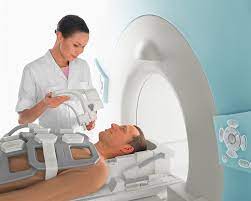PreNuvo: Innovative MRI Technology
High-resolution radiology is used in oncology for both diagnoses as well as screening and monitoring. Because cancer cell physiology is metabolically different from healthy cells, contrast media are preferentially taken up by cancer cells allowing for more precise imaging.
 Magnetic Resonance Imaging (MRI) was invented in the 1980s. It is a magnetic technology and does not expose patients to ionizing radiation, but to magnetic fields. Hence it is considered safer than exposure to the damaging, oncogenic ionizing radiation found in X-Rays and PET and CT scans
Magnetic Resonance Imaging (MRI) was invented in the 1980s. It is a magnetic technology and does not expose patients to ionizing radiation, but to magnetic fields. Hence it is considered safer than exposure to the damaging, oncogenic ionizing radiation found in X-Rays and PET and CT scans
Say No to Gadolinium
The most commonly used contrast medium used with MRI imaging to enhance resolution is Gadolinium. Gadolinium is a magnetic metal that is engineered into a nanoparticle solution and injected into the vein.
Gadolinium can damage both nephrons and neurons and is not completely excreted leading to toxic load over time. Because cancer patients may have multiple scans per year over many years, exposure to Gadolinium can become damaging and increasingly toxic. Gadolinium also acts as a calcium channel blocker and even at low concentrations can interfere with the contraction of smooth, skeletal, and cardiac muscle, nerve impulses, and blood coagulation.
Furthermore, there is a syndrome called Gadolinium deposition disease that is a gadolinium storage condition for which the long-term effects are not well understood. A common adverse effect of Gadolinium exposure and retention is renal fibrosis.
Patients should discuss the risks of ALL contrast media with the radiology team to evaluate risks and benefits and be fully informed before proceeding with any scan. Because all contrast media has toxicity, the opportunity to have a high-resolution scan without the use of Gadolinium contrast media is a very important innovation.
Patients with compromised cardiovascular, renal and neurologic function should use cautions before authorizing the performance of any scan without a full understanding of toxicity, risks, and benefits of contrast media
What if A High-Resolution MRI was possible without toxic contrast media?
PreNuvo has developed a High-Resolution MRI Scan that does not require the use of Gadolinium contrast media.
As with all technologies, MRI technology is advancing. Prenuvo is a company on the forefront of MRI Innovation bringing new safe and effective techniques not requiring contrast medium for high-resolution whole-body imaging, making accurate diagnosis possible.
Prenuvo uses innovative new hardware, software, and sequencing to create more detailed comprehensive images along with the use of Artificial Intelligence to enhance accurate analysis in less time. Prenuvo claims a 0.7% false-positive rate due to the higher resolution, often decreasing the need for additional follow-up imaging, biopsies, or surgeries. All without the use of Gadolinium or any other contrast media.
A more comfortable patient-centric experience:
A whole-body scan at Prenuvo typically takes 60 minutes compared to 5 hours for a conventional MRI. The scanner itself is wider and more open and less claustrophobic with fresh air vents. The machine is much quieter as opposed to the loud clanking of the conventional MRI. The design also allows the patient’s head to remain outside of the scanner for most of the scan. Innovative design and technology also solve many of the issues that lead to stress and anxiety for the patient that is common with MRI scans. Additionally, a headset and a music menu are provided to support relaxation.
For a faster, safer, less toxic, and highly accurate MRI without contrast, I recommend that you explore the use of prenuvo.com for your patients.
(NB: I have no financial relationship whatsoever with Prenuvo.)
- Gadolinium Retention and Toxicity-An Update.Ramalho M, Ramalho J, Burke LM, Semelka RC.
Adv Chronic Kidney Dis. 2017 May;24(3):138-146. doi: 10.1053/j.ackd.2017.03.004.
PMID: 28501075 Review. - Gadolinium-Induced Fibrosis.Todd DJ, Kay J.
Annu Rev Med. 2016;67:273-91. doi: 10.1146/annurev-med-063014-124936.
PMID: 26768242 Review. - Gadolinium contrast agents - are they really safe? Malikova H, Holesta M. J Vasc Access. 2017 Mar 28;18(Suppl. 2):1-7. doi: 10.5301/jva.5000713. Epub 2017 Mar 21. PMID: 28362042 Review.




